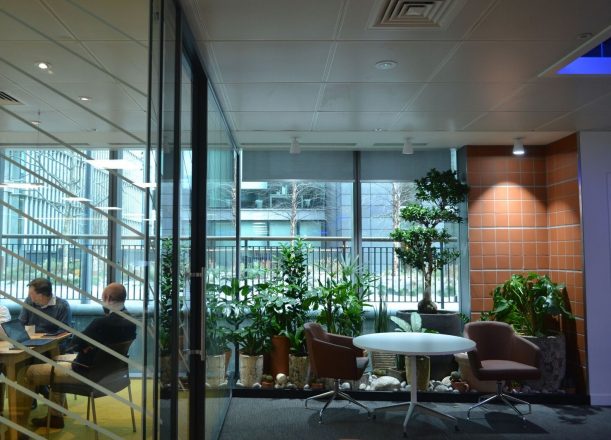Here at Box Architects, we believe that biophilic design is a wonderful direction for creativity. But is it just a new way to make people more efficient? We asked architect, Ania Tyszkiewicz, to investigate.
What is biophilic design? Essentially, it’s about creating spaces where people feel happy and more connected with nature. We continually strive to introduce elements of biophilic design in the spaces we create for our clients and the offices in which we work.
I was recently fortunate to hear a talk by writer and TV presenter, Oliver Heath. He is the founder of Heath Design Practice which advocates the use of biophilic design principles to create happier, healthier places to live and work.
My ambition as a designer and architect has always been to create spaces that are not only safe and functional but delightful, lively and inspiring. I left the event uplifted and determined to follow in Heath’s footsteps. I felt compelled to find ways of encouraging my colleagues to weave principals of biophilic design into our projects.
We live in a world obsessed by high productivity, fast work pace and continual change. Many more of us realise that contact with nature is beneficial to our health and wellbeing. A trip to the seaside charges our batteries and calms our senses. Time spent walking in a local park or forest is an opportunity to breathe in fresh and oxygenated air. Working in a space flooded with natural daylight and a stable room temperature can make us happier and more productive. Introducing live planting can make a difference. But all too often, these essential elements are missing from the spaces in which we live and work.
So how can we incorporate biophilic design in our projects? Well, we can start by introducing natural colours, patterns, textures and materials. Where possible, our work should use natural lighting and ventilation. And spaces should be filled with images of beautiful landscapes and live planting to inspire our senses. Even the simple act of encouraging staff to water a plant beside their desk can make a difference.
We have delivered a few projects with a strong biophilic design alongside our partners Futurebrand and CBRE.
We were involved in the rolling refurbishment of an international client’s London offices. In an increasingly competitive market, the workplace environment is a key way to attract the best talent. Our design had to reflect every element of our client’s brand presence and values.
We began with the reception area, IT and finance departments as well as every washroom, introducing splashes of colour, live planting, soft furnishing and natural lighting.
We decided to aim for the WELL Building Standard which focuses on the health and wellness of people in buildings. So, new informal breakout areas were designed featuring a mix of colours and natural materials – all surrounded by dense planting. We incorporated a wide variety of working, meeting and informal soft seating spaces to encourage collaboration between teams. Layouts were reconfigured to increase natural lighting levels wherever possible.
From our feedback with staff, we know that receptionists have embraced our decision to have an open reception area. Removing the barrier between staff and visitors has given the space a more informal, yet lively atmosphere. Our breakout areas are popular spaces that staff can use and enjoy fantastic views of west London.
But even introducing a single biophilic design element can have a big impact. A few years ago, we were also tasked with a major refurbishment of the former Lloyds Bank headquarters, a drab granite-clad early 1970s building in Leeds.
The ground floor – once a space for customers to deposit cheques and pay bills – has been reconfigured into a restaurant. An additional floor was created using cantilevered extensions. Today, it serves as office accommodation complete with exposed ceiling soffit and services. The building now has two new entrances. Crucially, introduced a double height contemporary reception area complete with a moss wall. The once austere space is now a warm, inviting meeting place for visitors.
Biophilic design is a wonderful direction for creativity aimed at shaping spaces where people feel happy and more connected with nature. It clearly has long-term benefits for us and more importantly, our environment.
